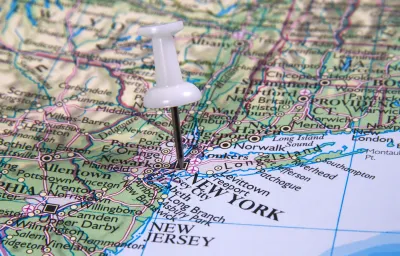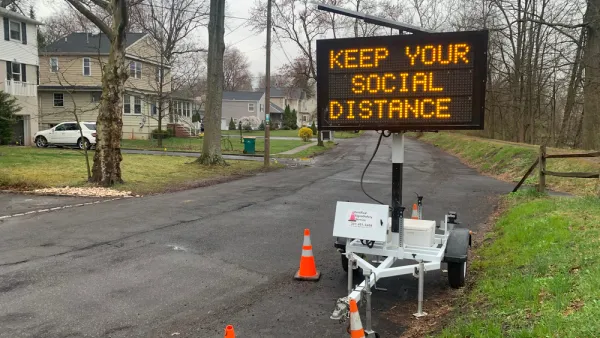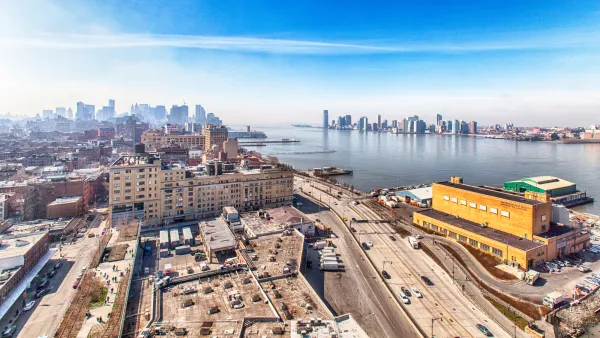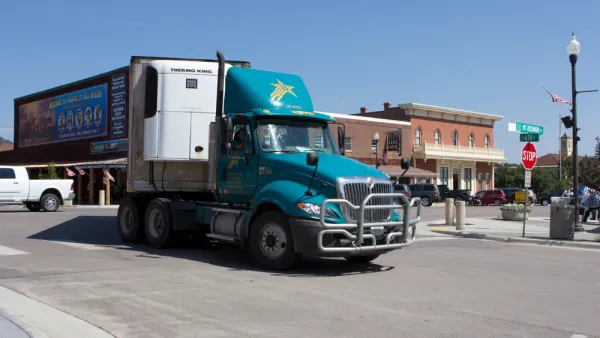High population density is viewed as an environmental benefit in terms of decreasing emissions, particularly from transportation, but from the public health perspective of containing the spread of COVID-19, it might be a significant negative.

Urban environmentalists and planners have long pointed to the benefits of increasing residential density, primarily in reducing carbon emissions from transportation and energy consumption in buildings, as well as other benefits such as reduced water consumption. However, high population density may be linked to the rate at which the coronavirus, declared a pandemic just a week ago, is spreading in the U.S.
Washington Post correspondent Phillip Bump discussed the relationship of population density and coronavirus in a political analysis that centered on President Trump's observation that until late on Tuesday, there were no reported cases of COVID-19 in West Virginia.
During Tuesday's White House morning briefing on the government’s response to the COVID-19 pandemic, Trump repeatedly noted that the three states with the most reported cases were New York, Washington and California, with 669, 708, and 369, respectively, per the CDC as of March 17 (scroll down to the map), in contrast to other states, particularly West Virginia.
[Correspondent's note: There are more comprehensive and up-to-date tracking websites. The New York State Department of Health reports "1,374 confirmed positive cases in New York York State" as of 8:15 PM on this date. The POLITICO live tracker also indicates the total number of tests administered, in addition to positive cases and deaths.]
Trump cited the absence of infection in the Mountain State as a reason not to agree to the strong federal approach to the outbreak advocated by New York Gov. Andrew Cuomo that includes establishing "a uniform federal standard for when cities and states should shut down commerce and schools, or cancel events."
Comparing New York and California to West Virginia, Bump observes:
Both are also far more populous states than West Virginia. There are nearly 20 million people in New York and about 40 million in California, compared with under 2 million in West Virginia. In other words, the number of coronavirus cases per 1,000 residents in West Virginia is zero. In New York, it’s 0.05. In California, 0.01.
More importantly, though, there’s been a correlation between the number of cases and population density. The most recent per-county data (from CSBS) shows that link. More density, more cases. [See dot graph.]
This makes sense, of course. More people packed into a tighter area is the main way in which the virus spreads. Hence the push for social distancing: Getting people away from one another will help stop the spread.
Bump goes on to point out what the president missed.
- No international flights arrive in West Virginia, the source of the original infection prior to community spread.["In the first case in Washington, the man in his 30s had been traveling in Wuhan, China, and returned home to Snohomish County, Wash., on Jan. 15," according to The New York Times.] "Fewer international travelers means a lower likelihood of early infection," notes Bump.
- "[Y]ou can’t confirm cases of infection if you don’t test. As of Monday, the state had tested only 84 people, less than one-tenth of the number of people who had both been tested in New York state — and had come back positive. The state’s commissioner for public health further indicated there were only supplies to test about 500 people in total."
Bump's most important observation is that notwithstanding its low population density, the state's population is at high risk of infection.
No state has a higher density of its population that is at higher risk from the virus than Gov. Jim Justice’s. Half of the state’s residents are either over 60 years old or have a health condition that means they might face complications should they contract covid-19, the disease caused by the virus.
Gov. Justice, like President Trump until recently, has downplayed the seriousness of the virus, tweeting on Monday that they should go out to restaurants. "If Justice is looking to see cases quickly begin to appear in his state, that’s a good way to do it," concludes Bump.
FULL STORY: Trump praised West Virginia for keeping coronavirus out. That’s not how this works.

National Parks Layoffs Will Cause Communities to Lose Billions
Thousands of essential park workers were laid off this week, just before the busy spring break season.

Retro-silient?: America’s First “Eco-burb,” The Woodlands Turns 50
A master-planned community north of Houston offers lessons on green infrastructure and resilient design, but falls short of its founder’s lofty affordability and walkability goals.

Delivering for America Plan Will Downgrade Mail Service in at Least 49.5 Percent of Zip Codes
Republican and Democrat lawmakers criticize the plan for its disproportionate negative impact on rural communities.

Test News Post 1
This is a summary

Test News Headline 46
Test for the image on the front page.

Balancing Bombs and Butterflies: How the National Guard Protects a Rare Species
The National Guard at Fort Indiantown Gap uses GIS technology and land management strategies to balance military training with conservation efforts, ensuring the survival of the rare eastern regal fritillary butterfly.
Urban Design for Planners 1: Software Tools
This six-course series explores essential urban design concepts using open source software and equips planners with the tools they need to participate fully in the urban design process.
Planning for Universal Design
Learn the tools for implementing Universal Design in planning regulations.
EMC Planning Group, Inc.
Planetizen
Planetizen
Mpact (formerly Rail~Volution)
Great Falls Development Authority, Inc.
HUDs Office of Policy Development and Research
NYU Wagner Graduate School of Public Service





























